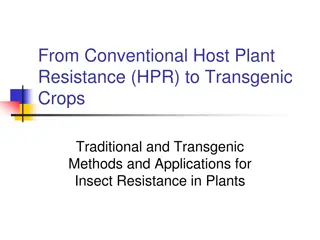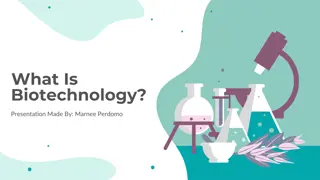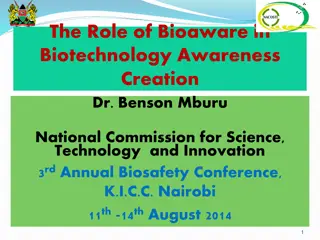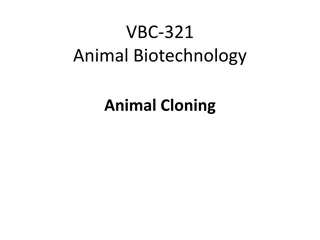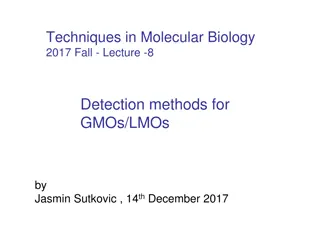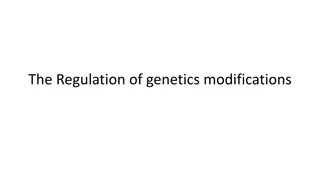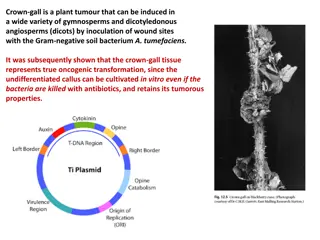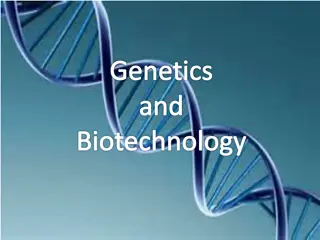Understanding Transgenic Plants and Agrobacterium Tumefaciens in Plant Biotechnology
Creation of transgenic plants involves various methods such as microprojectile DNA-coating, electroporation, and Agrobacterium transformation. Agrobacterium tumefaciens, a soil bacterium, plays a crucial role in inducing crown gall disease in plants by transferring T-DNA from the Ti plasmid. The Ti plasmid carries essential components for plant cell transformation and tumor growth. The genetic information on the Ti plasmid controls the integration of T-DNA into plant cells, leading to genetic modifications in transgenic plants.
Download Presentation

Please find below an Image/Link to download the presentation.
The content on the website is provided AS IS for your information and personal use only. It may not be sold, licensed, or shared on other websites without obtaining consent from the author. Download presentation by click this link. If you encounter any issues during the download, it is possible that the publisher has removed the file from their server.
E N D
Presentation Transcript
Transgenic Plants: Creation Dr. Kamal Kumar Gupta Associate Professor
Methods of production of Transgenic plants Microprojectile DNA-coated tungsten or gold particles into plant cells. Electroporation: use of a short burst of electricity to put the DNA into cells. Agrobacterium transformation bombardment: shooting tumefaciens-mediated
A. tumefaciens A. tumefaciens is a soil bacterium responsible for crown gall disease of dicotyledonous plants. The galls or tumors are formed at the junction between the root and the stem of infected plants.
Crown Gall Disease Agrobacterium tumifaciencs
The ability of A. tumefaciens to induce crown galls in plants is controlled by genetic information carried on Ti plasmid (tumor-inducing plasmid). Ti plasmid has two components the T-DNA (Transferred DNA) and the vir region, which are essential for the transformation of plant cells. During the transformation process, the T-DNA is excised from the Ti plasmid, transferred to a plant cell, and integrated into the DNA of the plant cell. The integration of the chromosomal sites. In some cases, multiple T-DNA integration events occur in the same cell. T-DNA occurs at random
Structure of Ti Plasmid T DNA: In nopaline-type Ti plasmids the T-DNA is a 23,000-nucleotide-pair segment It carries 13 known genes including genes encoding enzymes that catalyze the synthesis of phytohormones (the auxin indoleacetic isopentenyl adenosine). These phytohormones tumorous growth of cells in crown galls. The T-DNA region is bordered by 25-nucleotide-pair imperfect repeats One of this must be present in cis for T-DNA excision and transfer. acid and the cytokinin are responsible for the
Structure of Ti Plasmid The vir (virulence) region It contains the genes required for the T-DNA transfer process. These genes encode the DNA processing enzymes required for excision, transfer, and integration of the T- DNA segment. They are expressed at very low levels in A. tumefaciens cells growing in soil. Exposure of the bacteria to wounded plant cells or exudates from plant cells induces enhanced levels of expression of the vir genes. This induction process is very slow for bacteria, taking 10 to 15 hours to reach maximum levels of expression. Phenolic compounds such as acetosyringone act as inducers of the vir genes.
Structure of the nopaline Ti plasmid pTi C58, showing ori, origin of replication; Tum, genes responsible for tumor formation; Nos, genes involved in nopaline biosynthesis; Noc, genes involved in the catabolism of nopaline; vir, virulence genes required for T-DNA transfer. The nucleotide-pair sequences of the left and right terminal repeats are shown at the top; the asterisks mark the four base pairs that differ in the two border sequences
Ti plasmid vector for creating transgenic plants Foreign genes could be inserted into the T- DNA and then transferred to the plant. In the modified Ti plasmid the genes responsible for tumor formation are deleted Selectable markeris appropriate regulatory elements. added along with
Ti plasmid vector for creating transgenic plants The kanrgene from the E. coli transposon Tn5 has been used extensively as a selectable marker. it encodes an enzyme phosphotransferase type II (NPTII), it detoxify the kanamycin. The NPTII coding sequence are provided with a plant promoter and plant termination and polyadenylation signals. Such constructions with prokaryotic coding sequences flanked by eukaryotic regulatory sequences are called chimeric selectable marker genes. called neomycin
One widely used chimeric selectable marker gene contains the cauliflower mosaic virus (CaMV) 35S promoter, the NPTII coding sequence, and the Ti nopaline synthase (nos) termination sequence; this chimeric gene is usually symbolized 35S/NPTII/nos. The Ti vectors used to transfer genes into plants have the tumor-inducing genes of the plasmid replaced with a chimeric selectable marker gene such as 35S/NPTII/nos.
Limitations as routine Ti plasmid vectors The production of phytohormones by transformed cells prevents them from being regenerated into mature plants. A gene encoding opine synthesis is not useful to a transgenic plant and may lower the final plant yield Ti plasmids are large (approximately 200 to 800 kb). Ti plasmid does not replicate in Escherichia coli, therefore it cannot be cloned in E. coli. Transfer of the T-DNA, which begins from the right border, does not always end at the left border. Rather, vector DNA sequences past the left border are often transferred.
Ti plasmid-based vectors: Components A selectable phosphotransferase, put under the control of plant (eukaryotic) transcriptional regulation signals, including both a promoter and a termination polyadenylation sequence. An origin of DNA replication that allows the plasmid to replicate in E. coli . The right border sequence of the T-DNA region. Most cloning vectors include both a right and a left border sequence. A polylinker to facilitate insertion of the cloned gene into the region between T-DNA border sequences. A killer gene encoding a toxin downstream from the left border to prevent unwanted vector DNA past the left border from being incorporated into transgenic plants. If this incorporation occurs, and the killer gene is present, the transformed cells will not survive. marker gene, such as neomycin
Binary vector system The binary cloning vector contains either the E. coli and A. tumefaciens origins of DNA replication or a single broadhost range origin of DNA replication. All the cloning steps are carried out in E. coli before the vector is introduced into A. tumefaciens. The recipient A. tumefaciens strain carries a modified (defective or disarmed) Ti plasmidthat contains a complete set of vir genes but lacks theT-DNA region, so that this T-DNA cannot be transferred. With this system,the defective Ti plasmid synthesizes the vir gene products and acts as a helper plasmid. Thisenables the T-DNA from the binary cloning vector to be inserted into theplant chromosomal DNA. Since transfer of the T-DNA is initiated from theright border, the selectable marker, isusually placed next to the left border. A few binary vectors have been designed to include two plant selectable markers, one adjacent to the right border and the other adjacentto the left border.
Cointegrate vector system The cointegrate vector has a plant selectable marker gene, the targetgene, the right border, an E. coli origin of DNA replication, and a bacterial selectable marker gene. The cointegrate vector recombines with a modified(disarmed) Ti plasmid that lacks both the tumor-producing genes and theright border of the T-DNA within A. tumefaciens. The entire cloningvector becomes integrated into the disarmed Ti plasmid to form a recombinantTi plasmid



